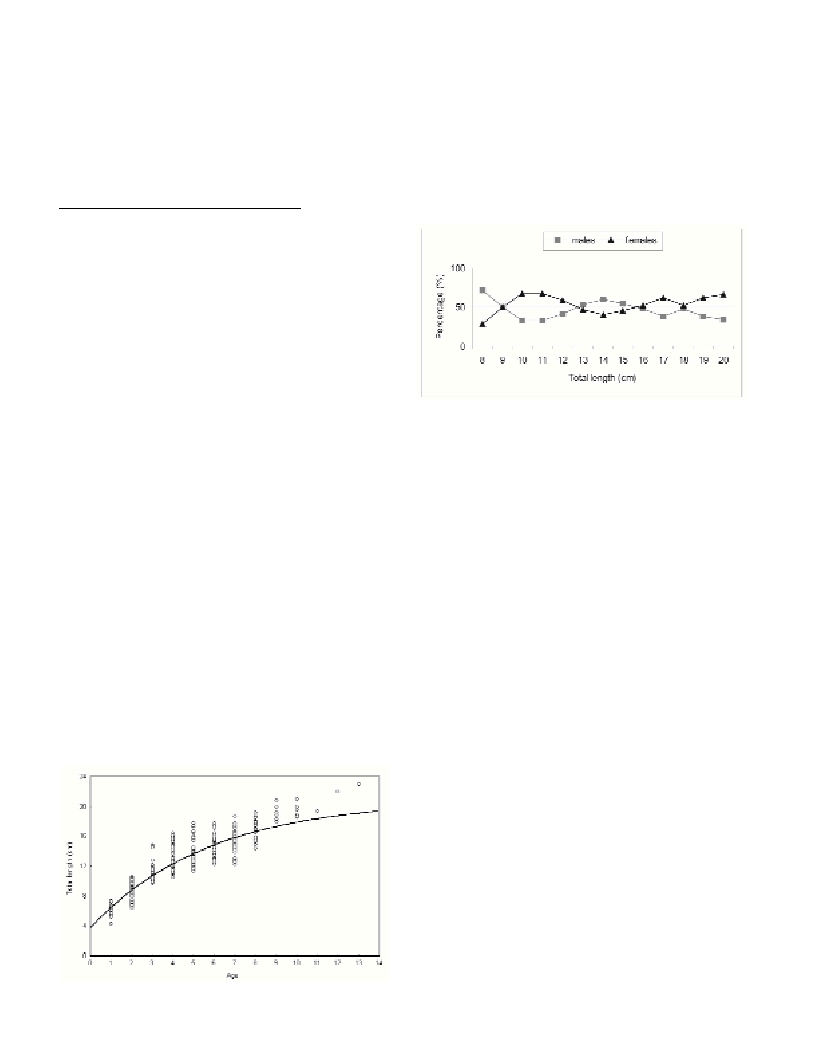POPULATION STRUCTURE OF ANNULAR SEA BREAM, DIPLODUS ANNULARISL.,
IN THE EASTERN ADRIATIC SEA
S. Matic-Skoko*, M. Kraljevic and J. Dulcic
Institute of Oceanography and Fisheries, Split, Croatia - * sanja@izor.hr
Abstract
The total length of 1872 individuals of Diplodus annularisranged from 3.3 to 20.0 cm. Maximum age was 13 yr and the 5-yr old
individuals dominated the catches (24.75%). The parameters of the von Bertalanffy growth equation were: L
8
= 22.6 cm, K=0.173 yr
-1
and
t
0
=-1.460 yr. The overall male: female ratio was 1:1.12.
Keywords: Diplodus annularis, growth, Adriatic
Rapp. Comm. int. Mer Médit., 37,2004
399
Introduction
Annular sea bream Diplodus annularisis a demersal marine fish
found in groups in sandy bottoms and seagrass bed habitats, at depths
ranging from 0 to 50 m. It is distributed from the Gulf of Biscay to
Gibraltar, around Madeira and Canary Islands, as well as in the
Mediterranean, Black and Adriatic Seas (1). Although, it is common
in the Adriatic Sea, there is a lack of data on its biology and ecology
in this area.
Material and methods
Samples were collected on monthly basis (2000-2002), in the
eastern Adriatic Sea, from commercial catches (trawl: 20 mm mesh
size, knot-to-knot; beach seines: 6 mm mesh size). Overall 1874
specimens were collected of which 1694 (90.0%) were mature. Age
was determined by reading scales from 699 individuals caught in May
(91 juveniles and 608 adults). The non-linear least square regression
procedure was used to estimate the growth parameters L
8
, Kand t
0
of
the von Bertalanffy equation (2).
Results and discussion
A total of 1872 specimens were analyzed, ranging in size from 3.3
to 20.0 cm total length TL (mean 12.38 ±2.532 cm), of which 799
(42.68%) were males and 895 (47.81%) females. Males ranged in size
from 8.7 to 20.0 cm TL (mean 13.11 ±1.744 cm) and females from
7.5 to 19.6 cm TL (mean 12.75 ±1.943 cm). The TL frequency
distribution exhibited a mode at 12-14 cm. An increase in TL from
NW to SE, and from the coastal zone to the open sea was observed.
There is no previous data on the length structure of D. annularis
population in the study area.
Maximum age was 13 yr (for a female individual). The oldest male
was 11 yr old. The estimated von Bertalanffy growth parameters were:
L
8
= 22.6 cm (SE = 0.054), K=0.173 yr
-1
(SE = 0.003) and t
0
=-1.460
yr (SE = 0.015) (R
2
=0.890) (Fig. 1). Overall, the 5-yr old individuals,
with lengths 11.3-17.8 cm TL, dominated (24.75%) the catches. Our
results differ from those from Canary Islands (3), due to faster growth
and shorter life cycle of D. annularisin that area (maximum age of
6yr,L
8
= 24.85 cm, K = 0.259 yr
-1
and t
0
= -0.871 yr).
In the eastern Adriatic Sea the overall male (799) to female (894)
ratio of D. annulariswas 1:1.12 and changed according to length
classes (Fig. 2). This species is a rudimentary hermaphrodite (4) and
observed sex ratio is a consequence of this fact. It is evident that in
length range from 10.0 to 16.0 cm TL, males and females had similar
distributions. Predominance of males in lower length classes
(<9.0cm) is mainly determined by nature of the sexual change,
namely protandric hermaphroditism, as it was reported for
D.annularisfrom Canary Islands (5).
References
1-Jardas I., 1996. Sparidae. Pp. 265-285. In: Matekalo DraganovicJ.
(ed.), Jadranska ihtiofauna. kolska knjiga, Zagreb.
2-Ricker W.E., 1975. Computation and Interpretation of Biological
Statistics of Fish Populations. Bull. Fish. Res. Board Can., 191: 382 p.
3-Pajuelo J.G., Lorenzo J.M., 2002. Age and growth of the annular
seabream, Diplodus annularis(Pisces: Sparidae), from the Canarian
archipelago (central-east Atlantic). Sci. Mar., 28: 1-11.
4-Matic-Skoko S., 2003. Fishery-biological and ecological charac-
teristics of annular sea bream (Diplodus annularisL.) in the eastern
Adriatic Sea. PhD Thesis, University Zagreb, 165.
5-Pajuelo J.G., Lorenzo J.M., 2001. Biology of the annular seabream,
Diplodus annularis(Sparidae), in coastal waters of the Canary Islands.
J.Appl. Icht., 17: 121-125.
Fig. 1. von Bertalanffy growth curve of Diplodus annularisin the eastern
Adriatic Sea.
Fig. 2. Sex ratio of Diplodus annularisin the eastern Adriatic Sea.

